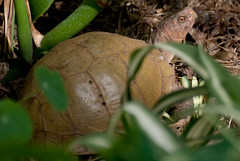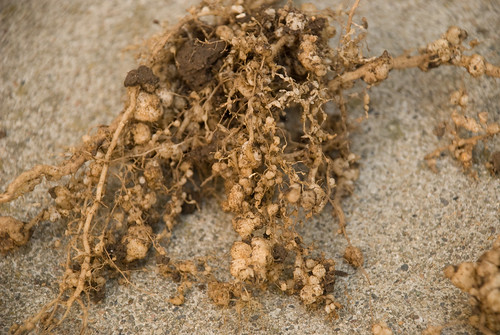How did I know I had Root Knot Nematodes?
Viz:
A quick lookup told me that I had Root Knot Nematodes.
How do you get them?
How did I get them? I don't know. At least nothing for sure. I know that I didn't have them (or didn't have them bad enough to cause a problem) for the first several years here and in that location. For the first several years I grew tomatoes -- big tomatoes, little tomatoes, cherry tomatoes, beefsteak tomatoes, lemon tomatoes, pear tomatoes -- all along that space. Mind you, I planted these tomatoes in a different location along this walkway every year. First at one end, then the other, then in the middle.
Then, suddenly one year, the tomato crop was minimal. And the next year the plants wouldn't even grow. And the year after, they grew a while, but then acted like they had a really bad case of the wilts. In retrospect, it was probably all nematodes.
But the thing is that there were two things I did between when the tomatoes were awesome and when they were crap. The first was that I tried product that contained (among other things) mychorrizal fungi. These fungi are supposed to help build a soil-building web of organisms to make plants grow more efficiently. (For a while I was suspecting that this product -- full of living organisms -- was the culprit.) The other thing was that I accepted some home-grown transplants for that bed.
And that's how it usually happens: infected soil is added to "clean" soil. OK. So that's kind of the "good" news. My infected planting zone is pretty much bounded on all sides by concrete. It's a planting bed between a garage wall and a walkway and a driveway and a porch. And the builders were a little sloppy when they dug the footings and built the concrete frames, so most of the space is also bounded on the bottom by concrete.
How do you get rid of them?
The bad news? You can't. Like, you just CAN'T.
Well, if you excavate ALL the infected soil and replaced it with "clean" soil, they'd be gone. But, if you don't get every last stinking nematode, they'll reproduce and eventually return. And, there *might* be a chemical you could apply and have it actually work, but pretty much all but a couple of chemicals have been banned as being WAY too toxic for everything else. And the ones that are still legal aren't completely effective. Honestly, if you don't apply them when the soil has the right level of moisture and the right temperature to the right depth with the right equipment, they're apparently almost completely INeffective. (Some of these chemicals are called "fumigants" because they are gaseous.)
The "good" news is that most of the "organic" solutions are relatively effective at keeping the nematodes under control. The idea is, make the soil healthy and the healthy-soil organisms will help kick nematode butt. Specifically:
- Add lots and lots of compost and other organic matter.
- Use a non-host (more on this in a bit) cover crop then turn it under as a "green manure."
- Use plenty of organic fertilizers such as bone meal to increase phosphorous and potassium.
- Rotate your crops so you're not growing related plants in the same place each time (e.g., tomatoes, eggplant, and pepper are all related, so don't plant peppers where you planted tomatoes or eggplant last year).
- Let the area go fallow periodically as part of the crop rotation plan.
- When you let the area go fallow, use a non-host plant to hold the space.
Host vs. Non-Host, Cover Crops, Green Manures
Simply, a "host" plant is one that the root knot nematodes really enjoy. A non-host plant is completely inhospitable to the root knot nematodes. Except that it's not that simple. There's a continuum of host/non-host plants. From what I have been able to gather, grasses (like sorghum, barley and other grains) lean toward the non-host end. Hosts are all the yummy things like cucumbers (and melons, squash), tomatoes (and eggplant, peppers, potatoes), carrots, lettuce, and so on.
Interestingly, the brassicas (cabbage, broccoli, cauliflower, radish, turnip, etc) lean toward the non-host end of things. Also in the brassicas are field mustard and rape. Here, in what's now known as Silicon Valley, the orchards that once filled the valley used to use field mustard as a cover crop/green manure under the fruit trees. Late every winter, the valley was covered in yellow blossoms with dormant fruit trees poking out above the sea of yellow. Come spring, the orchardists would disc all the mustard into the soil. A few weeks later, the orchardists would come back and plow in the irrigation furrows.
One of the things I learned when researching what I could do about my infestation was that, during the breakdown of the field mustard, certain gasses (fumigants) are released that kill the root knot nematodes! And, as we already saw, the organic material helps feed the other organisms that kick nematode butt. Awesome!
What am I going to do about them?
Well, for now, I'm growing this winter's crops in recycled recycling bins above the infested soil.
In the meanwhile, I'll be adding massive quantities of compost to the soil along with sulfur (to help correct the pH), rock dust (to add in elemental micronutrients), and bone meal (to boost the phosphorus level). I'm going to try to track down a local source of field mustard or rapeseed to grow a non-host cover crop/green manure.
I plan to leave the bed basically fallow for at least a year, so next spring I'll be planting summer veggies in the tubs again. But before I do that, I'll let the tubs dry out (so they won't be quite so heavy to lift), move them out of the way, and turn under the cover crop.
Another suggestion for helping rid the soil of nematodes is "solarization." So, I was thinking about covering that strip with plastic before moving the tubs back into place. In that way, the space can have the whole summer to try to build up enough heat to bake the little buggers. (And, maybe it will help trap the gasses produced by the breakdown of the green manure.)
Wish me luck!













Yuck! I've had these before, though I didn't know what they were at the time. I was actually going to suggest baking them out, under the assumption that they've *got* to have a maximum temperature they'll tolerate. Cover 'em with black plastic, turn over the soil every week or so (so they can't burrow away), and you might be all set.
ReplyDeleteIn the category of "Treatments that would work, but probably aren't legal" - there's always Fuming Nitric Acid. That'll kill anything. And it eventually degrades into fertilizer. You'd have to keep that plastic over the soil, for sure :-)
Fuming nitric acid. Hehehe. Ummm... No.
ReplyDeleteAs to the clear/black plastic controversy, the scientists are currently coming down on the side of the clear plastic. Tho' I have heard now that they're throwing *red* plastic into the mix in the "which generates more warmth in the soil" debate.
I don't really want to completely sterilize the soil. You really want to have all that *other* living stuff in there to help things grow. For instance, did you know that there are like a zillion species of nematodes? Did you know that a bunch of them actually *kill* root knot nematodes? Further, there are a bunch of other organisms that also eat, attack, or otherwise parasitize root knot nematodes.
BTW- I plan to do another post on nematodes, root knot and otherwise.
Luck with all that. You're a far more dedicated gardener than I am.
ReplyDeleteThanks! for the luck.
ReplyDeleteI don't know that I'd call myself a "dedicated gardener." It's more like, dammit!, I wanna grow what I wanna grow here! Now, how do I do that? And I'm willing to try things (so long as they are not heinously pricey) and I'm interested in researching to learn about things to try (so long as they are not heinously pricey).